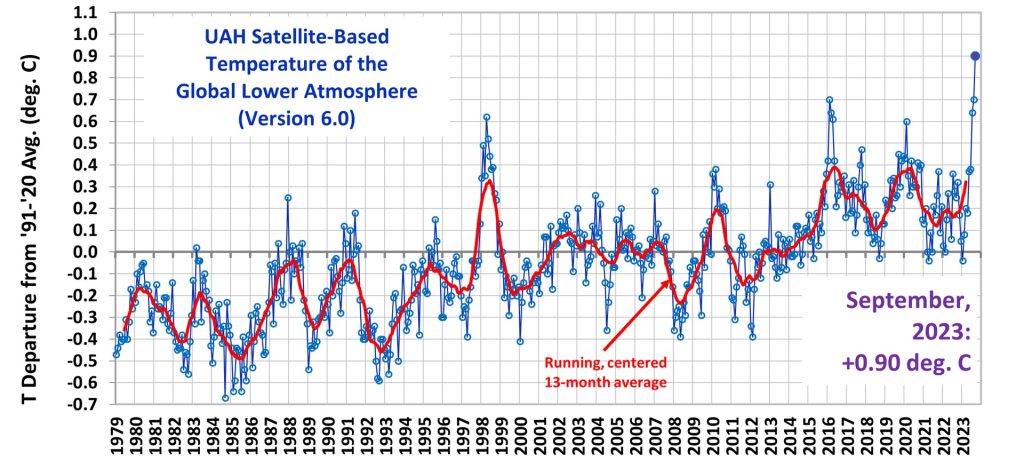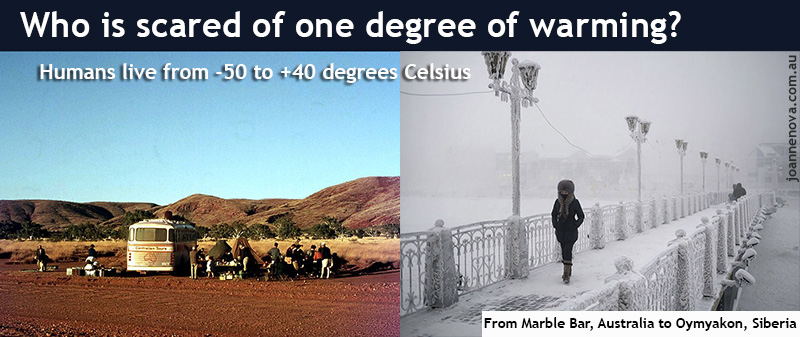
Humans live in a 90 degree range from Marble Bar, Australia to Oymyakon, Siberia. | Photos: Marble Bar, Wilford Peloquin, Oymyakon (and more glorious ones) by Amos Chapple.
The “hottest ever” headline is misleading
While the UAH satellite measurements are the hottest by far of the 44 year satellite record, nothing about the “hottest ever” media frenzy makes sense — not for health, history, the long term, or human biology. It’s only the “hottest ever” if we ignore most of the last ten thousand years. It’s just another attempt to scare people out of their money.
The latest UAH satellite measurements may be affected by the water vapor launched into the atmosphere by the Hunga Tonga volcano. There don’t appear to be any clear details about that, but even if we accept this as is, it’s still nothing to spend a trillion dollars on:
In the big scheme of human history, the world has been a lot hotter and a lot colder. Homo sapiens are 37 degree animals who retire to warm climates, not cold ones. Most people on Earth live in the warm tropics, not the cold poles. Two hundred million years of evolution mean mammals are made to deal with temperature change. We live in places that range from minus 50C minimums to plus 40C maximums (-58F to 107F). That’s a ninety degree temperature range (or 160F), and yet we’re supposed to panic if the world heats by half a degree more?
The hottest inhabited place on Earth is probably Kebili, Tunisia, where 60,000 people live and the average July maximum is 41.7°C (107F). And Marble Bar, Western Australia, has had an average of 41°C in January for the last 100 years (106F). Fossil Fuels make it possble. Give the poor air conditioning!
The coldest inhabited place is Oymyakon, Siberia, Russia, where 500 people live even though the average temperature for January is -50°C (-58F). These are the average temperatures, not the hottest and coldest days.
Almost every day of the year we deal with five to twenty degrees of warming, and that’s just dawn to afternoon tea.
Humans hate the heat right?
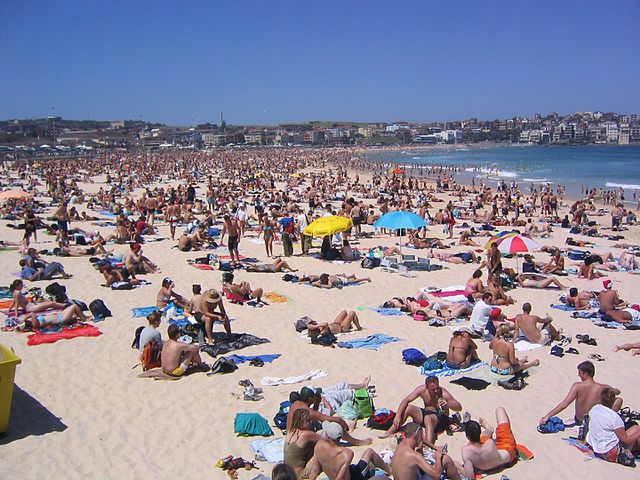
Bondi Beach, Sydney | Photo by Phil Whitehouse from London
Cold is the big threat to crops and lives, not heat
Human mortality rises 6 – 20 times higher in winter, even in hot cities like Brisbane, Australia. The biggest climate threat humans face is the next ice age. Twenty thousand years ago there were walls of ice a kilometer high over New York — that’s 2,000 feet of frozen water that has to melt before you can plant one plum tree.
The “Hottest Ever September” was just the hottest in the 40 year satellite record. The world was likely hotter in Roman Times, hotter in Minoan Times, and hotter during the Holocene peak 7,000 years ago. Sea levels were 1 – 2 meters higher then, when humans lived in mudhuts and teepees. Yet somehow humans thrived.
Seven thousand years ago the world was hotter than even our “hottest ever September” and yet the Great Barrier Reef survived, the Amazon forests grew and even polar bears and penguins were not wiped out. Only 6,000 years ago the world was warmer and the Sahara was lush green and wet.
In the West, wise academics could be speaking up to give us some perspective, yet they’re silent. What do taxpayers pay them for if not this? Our public funded media could be giving us the whole truth and nothing but the truth. Our ABC, BBC, CBC and NPR have specialist “science units” for reporting science, not just the one-sided propaganda that screws money from taxpayers, and feeds childhood anxiety.
These institutions have no problem reminding us how CO2 hasn’t been this high for 4 million years, but they forget day after day that temperatures have been and for thousands of years.
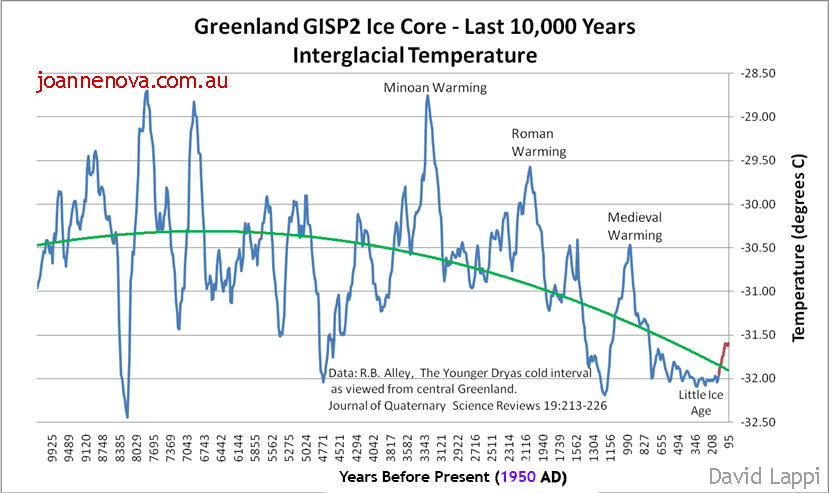
UPDATE: This graph shows the ice-core data up until 1855. The last 150 years (1705 to 1855) are highlighted in red to show the warming as the Earth began coming out of the LIA.
Sea levels have been falling for 7,000 years:
Western Australia is one of the oldest and most stable parts of Earth, making it an ideal place to study sea levels. We’re worried about seas rising by 3mm a year (and only after the satellites were “adjusted”) but the oceans rose 125 meters, stayed high for thousands of years and have been falling for most of human civilization.
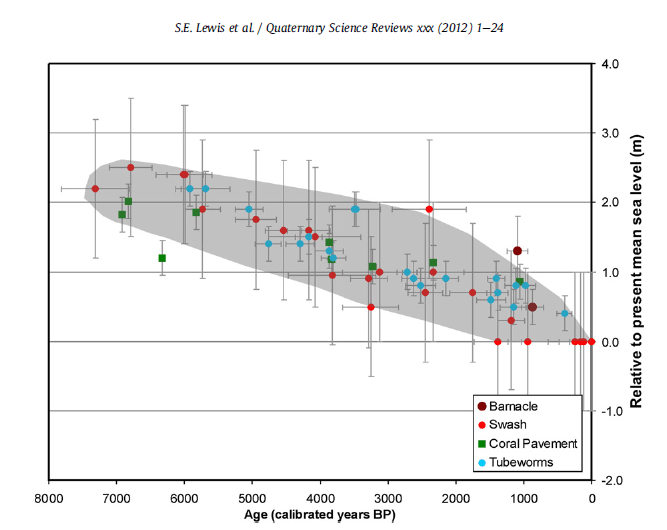
Sea level has been falling for 7,000 years in Western Australia
Save the world from witchdoctors. Teach children geology and the history of the Earth.
___
PS: Any miners reading this with photos of Marble Bar they don’t mind me using? Please send them in. There are surprisingly few photos available on any copyright-free libraries. Somewhere out there someone must have a photo of shimmery heat rising off bitumen!
REFERENCE:
Lewis, S.E., et al., Post-glacial sea-level changes around the Australian margin: a review, Quaternary Science
Reviews (2012), http://dx.doi.org/10.1016/j.quascirev.2012.09.006 [abstract] (paywalled).
